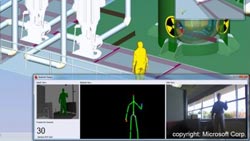Kinect Makes Dangerous Work Processes Safer

<br>
Kinect technology recognizes a person's movements and posture and transfers them to an avatar in a virtual environment. In the same way that a player moves intuitively within the scenes of a computer game, technicians can use Kinect to simulate movements in the workplace.
In its Product Lifecycle Management Software, Siemens Industry already provides interfaces to systems that precisely measure people's movements. Because such solutions are frequently complex, however, Siemens has now developed a version based on the Kinect sensor that is more user-friendly, although not as precise. The new solution makes the system available for other industrial applications, such as the planning of dangerous tasks.
Only a few major industries currently use systems that digitally track movements. The automotive industry is one example, which employs such systems to make assembly line workplaces more ergonomic or to design vehicle interiors. With the help of multiple cameras, electromagnetic sensors or full-body suits, the systems can measure the movements of people wearing special markers to within a single millimeter.
The technology is complex and can only be operated by appropriately trained staff. To develop a simpler system based on Kinect technology, the engineers from Siemens had to appropriately process the data. Although the Kinect sensor recognizes movements, it doesn't measure them precisely. That's why the developers use libraries containing simulation models for typical movements and combine these models with the information supplied by the Kinect sensor.
The first application to be created was a solution for planning service and maintenance work at nuclear power plants in the U.S. The application aims to ensure workers are exposed to a level of radiation that is as low as reasonably achievable (ALARA). To do this, technicians or planners operate the Kinect sensor-equipped simulation program and carry out specific work within a virtual environment. In reality, these environments would be exposed to radiation due to radioactivity. The program calculates the radiation dose that the virtual technician receives. The system helps the planners vary the individual work steps and the design of the workplace in order to reduce the dose to the lowest reasonably achievable level. Similarly, the system could also be used to plan work in chemically contaminated environments or to conduct traditional ergonomics tests.
Media Contact
More Information:
http://www.siemens.com/innovationnewsAll latest news from the category: Information Technology
Here you can find a summary of innovations in the fields of information and data processing and up-to-date developments on IT equipment and hardware.
This area covers topics such as IT services, IT architectures, IT management and telecommunications.
Newest articles

Sea slugs inspire highly stretchable biomedical sensor
USC Viterbi School of Engineering researcher Hangbo Zhao presents findings on highly stretchable and customizable microneedles for application in fields including neuroscience, tissue engineering, and wearable bioelectronics. The revolution in…

Twisting and binding matter waves with photons in a cavity
Precisely measuring the energy states of individual atoms has been a historical challenge for physicists due to atomic recoil. When an atom interacts with a photon, the atom “recoils” in…

Nanotubes, nanoparticles, and antibodies detect tiny amounts of fentanyl
New sensor is six orders of magnitude more sensitive than the next best thing. A research team at Pitt led by Alexander Star, a chemistry professor in the Kenneth P. Dietrich…





















